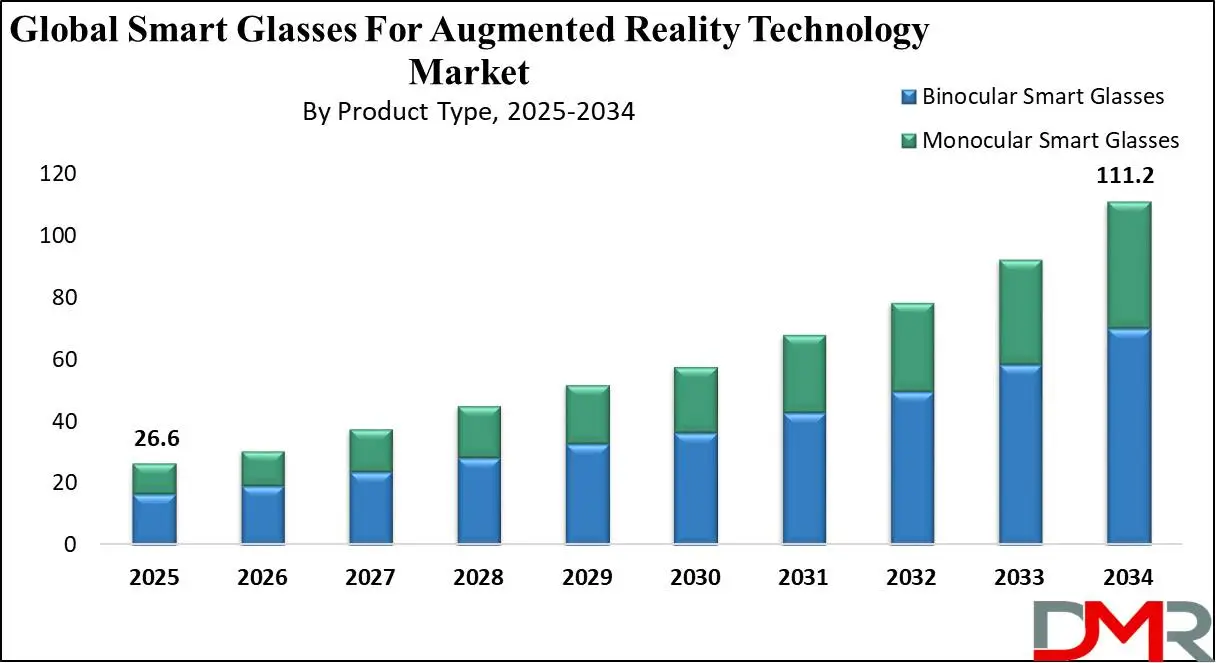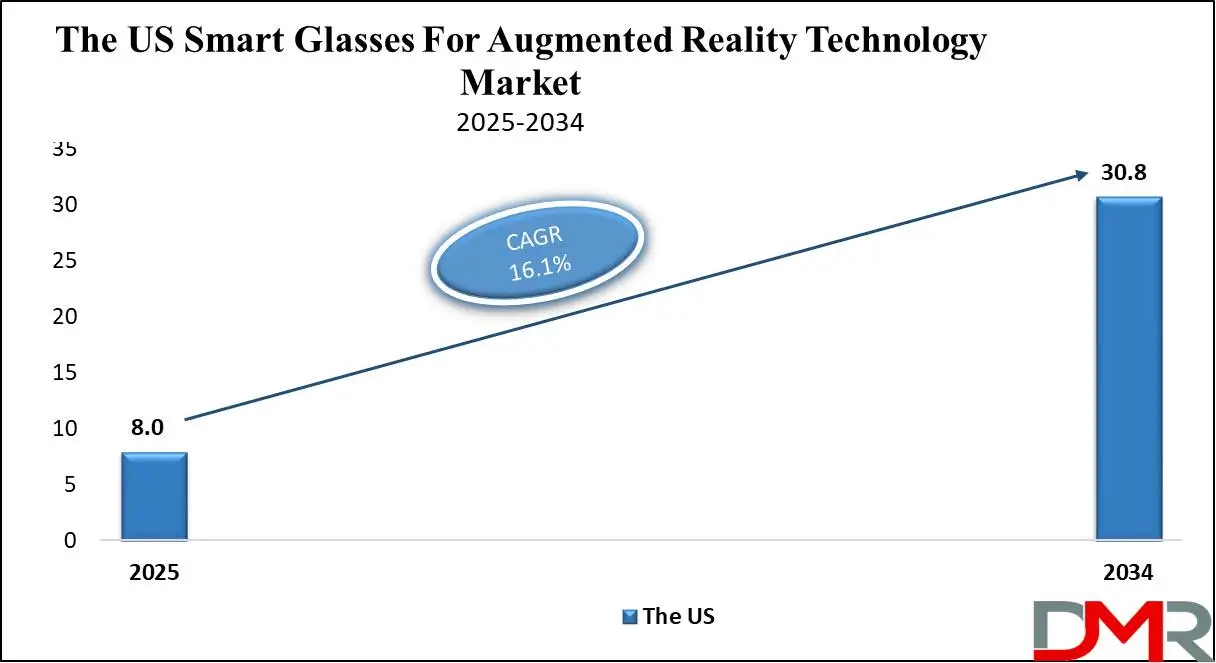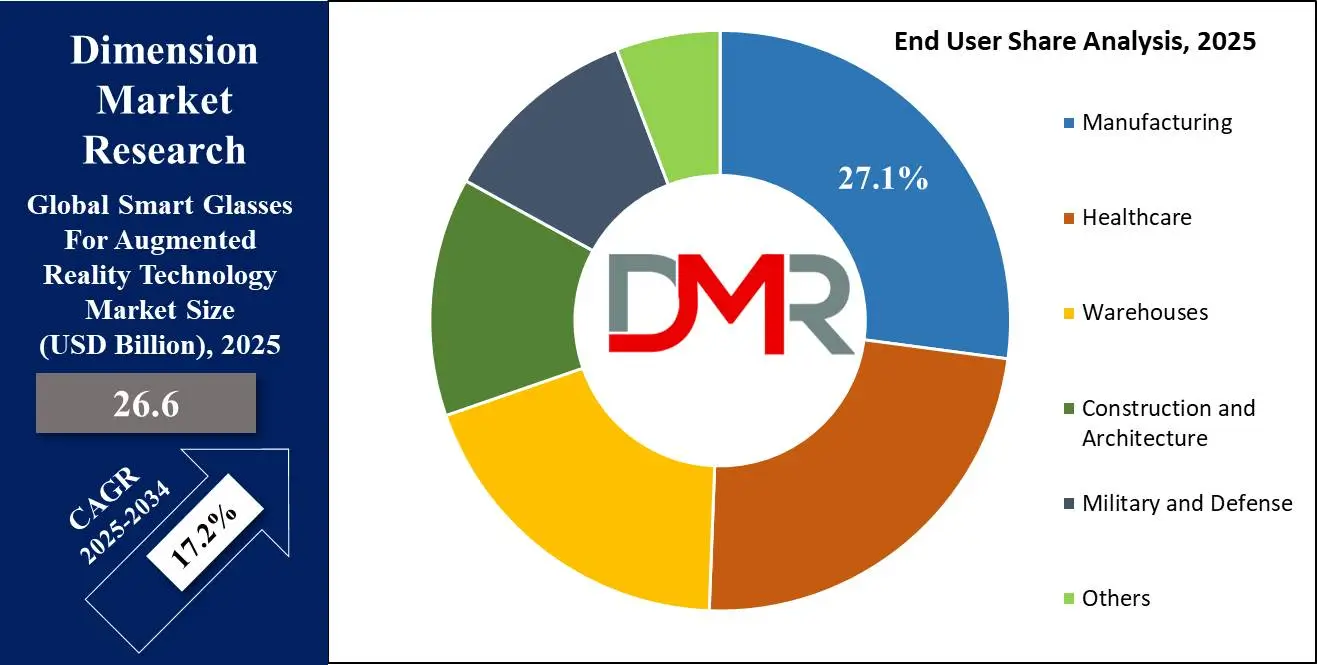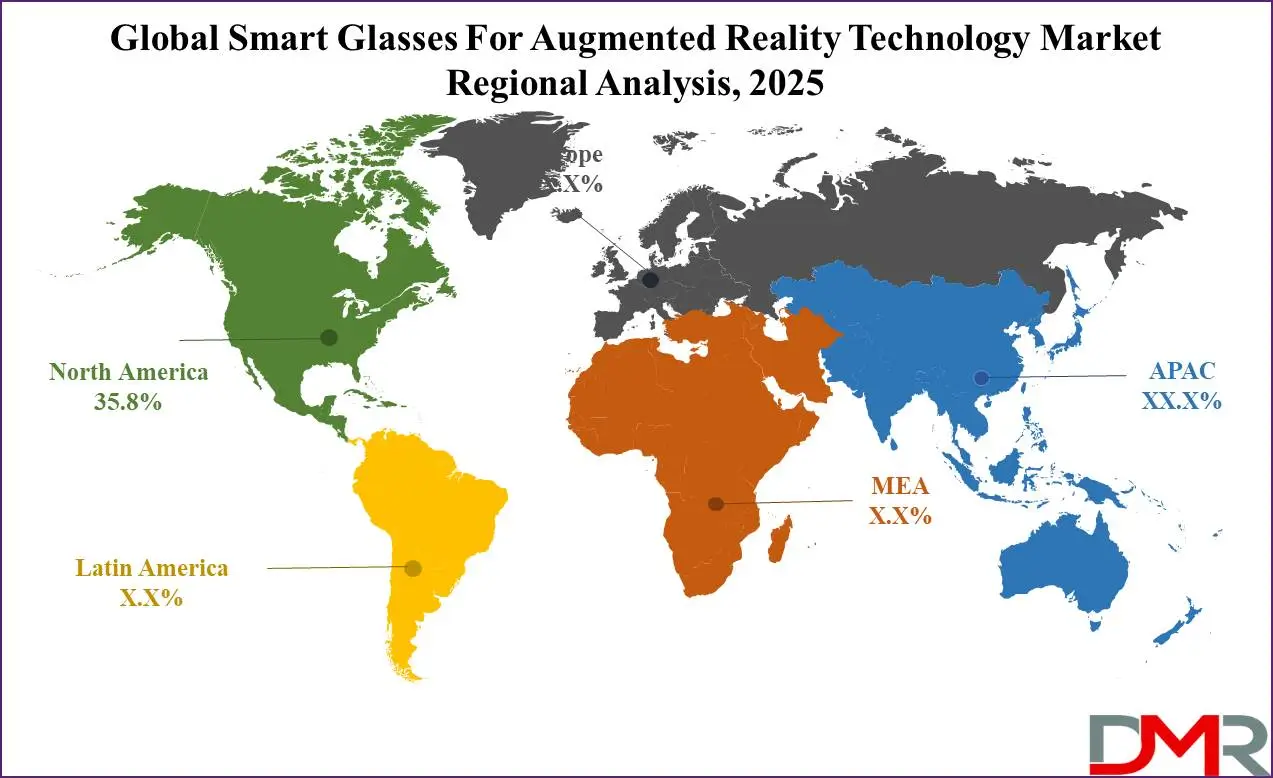Market Overview
The Global Smart Glasses for Augmented Reality (AR) Technology market is predicted to be valued at
USD 26.6 billion in 2025 and is expected to grow to
USD 111.2 billion by 2034, registering a compound annual growth rate
(CAGR) of 17.2% from 2025 to 2034.
.webp)
Smart glasses equipped with Augmented Reality (AR) technology are revolutionizing how people engage with digital information in the real world. Wearable devices equipped with AR overlay digital visuals, data, and interactive elements onto user fields of view to augment perceptions of reality; in contrast to virtual Reality (VR) headsets which create immersive virtual environments, AR glasses seamlessly incorporate digital content with physical environments for an easier computing experience that doesn't involve hands.
Major tech firms such as Apple, Meta, and Microsoft are designing cutting-edge AR glasses with features like voice control, eye tracking, and real-time spatial mapping for various uses such as gaming and entertainment industrial training, healthcare delivery, or remote assistance.

Surgeons using AR glasses for guided procedures while field technicians receiving real-time instructions without looking away from their work can benefit greatly from using these devices. AR smart glasses have come a long way with advances in artificial intelligence (AI) and 5G connectivity, becoming more lightweight, stylish, and capable. But issues including battery life, privacy concerns, and high costs must still be overcome before AR glasses play their true potential in shaping human-computer interaction; connecting digital with physical worlds.
The US Smart Glasses for Augmented Reality Technology Market
The US smart glasses for augmented reality (AR) technology market is projected to be valued at USD 8.0 billion in 2025. It is expected to witness subsequent growth in the upcoming period as it holds USD 30.8 billion in 2034 at a CAGR of 16.1%.

U.S. smart glasses market for Augmented Reality (AR) technology is being propelled forward by rising demands across industries like healthcare, manufacturing and retail to allow hands-free operations without using tools or GPS navigation devices. Adopting AR for remote assistance, training or navigation further increases demand while advances like AI, 5G and edge computing improve performance making AR glasses even more practical; rising consumer interest in immersive experiences such as gaming further push market growth forward.
Integration of AI and machine learning enhances real-time interactions, leading to the rise of enterprise applications such as remote collaboration and field service support, among many others. Furthermore, increasing interest in mixed reality (MR) solutions such as metaverse applications or healthcare-driven innovations is shaping AR smart glasses' futures.
Smart Glasses for Augmented Reality Technology Market: Key Takeaways
- Market Growth: The global Smart glasses for augmented reality (AR) technology market is anticipated to expand by USD 80.5 billion, achieving a CAGR of 17.2% from 2025 to 2034.
- Type Analysis: Hardware are predicted to lead the market based on type with the highest revenue share in 2025.
- Display Technology Analysis: Optical See-Through Smart Glasses are anticipated to lead the market with the highest revenue share by the end of 2025.
- Product Type Analysis: Binocular smart glasses are anticipated to lead the smart glasses for augmented reality (AR) technology market with revenue share in 2025.
- End User Analysis: Healthcare segments are likely to continue to dominate the market with a highest revenue share by the end of 2025.
- Regional Analysis: North America is projected to dominate the global smart glasses for augmented reality (AR) technology market, holding a market share of 35.8% by 2025.
Smart Glasses for Augmented Reality Technology Market: Use Cases
- Healthcare and Surgery: Smart glasses equipped with AR technology can assist surgeons by overlaying critical patient data, such as CT scans and vital signs, onto their field of view during surgery. This hands-free access to real-time information enhances precision and reduces the need for looking away at external monitors, ultimately improving patient outcomes. The integration of Augmented and Virtual Reality in Healthcare is transforming surgical procedures, diagnostics, and medical training with immersive and intelligent solutions.
- Manufacturing and Maintenance: In industrial settings, AR-enabled smart glasses help workers perform complex assembly tasks, repairs, and maintenance by displaying step-by-step instructions directly in their line of sight.
- Retail and E-Commerce: Smart glasses enhance the shopping experience by allowing customers to see virtual try-ons of clothing, accessories, or even furniture in their home environment.
- Education and Training: AR smart glasses revolutionize education and workforce training by providing immersive learning experiences. Students and trainees can interact with 3D models, access real-time guidance, and participate in hands-on simulations.
Smart Glasses for Augmented Reality Technology Market: Stats & Facts
- According to Statista, the total number of smart glasses users in the United States was expected to reach 12.61 billion in 2023. Furthermore, the adoption of smart glasses among Americans is projected to grow to 13.72 billion by the end of 2024 and 14.39 billion by 2025.
- According to Research and Markets, the market share of Augmented Reality (AR) and Virtual Reality (VR) smart glasses was estimated to be $15.93 billion in 2023. This market is expected to expand significantly, reaching approximately $29.3 billion by the end of 2027, with a compound annual growth rate (CAGR) of 16.4%.
- According to Statista, global AR glasses unit sales were around 2.11 billion in 2023, and this figure is anticipated to grow to 3.9 billion by the end of 2024.
- According to ARtillery Intelligence, the market value of both software and hardware AR glasses increased by $6.77 billion in 2023, marking a 104.3% rise compared to 2022. Additionally, the revenue share of AR glasses is predicted to grow fivefold by the end of 2026, reaching approximately $35 billion.
Smart Glasses for Augmented Reality Technology Market: Market Dynamic
Driving Factors in the Smart Glasses for Augmented Reality Technology Market
Display and Optics Technology AdvancementsMicrodisplays, waveguides, and projection systems have emerged as major driving forces behind smart glasses for augmented reality (AR). High-resolution OLED and micro-LED displays improve visual clarity, while advanced waveguide optics improve transparency and field of view. These innovations make AR glasses more immersive, lightweight, and energy-efficient while meeting consumer and enterprise demand alike.
Furthermore, advances like eye-tracking technology enhance usability and comfort, attracting industries like healthcare, manufacturing, and retail. As display technologies advance, AR smart glasses become ever more appealing both professionally and personally. As they evolve, smart glasses become even more practical and appealing for both professional and daily use.
Growing Businesses and Industrial Applications
Industry adoption of AR smart glasses in healthcare, logistics, and manufacturing has propelled market expansion. Businesses use them for hands-free data visualization, remote assistance, and real-time collaboration, improving efficiency while cutting operational costs. Surgeons use AR glasses during procedures, while warehouse workers leverage them for inventory optimization using AR navigation. Industrial maintenance teams utilize overlays as troubleshooting aids, while field services use them to troubleshoot or train staff members on proper procedures.
Companies prioritizing digital transformation find AR glasses offer them a competitive edge, leading to high demand as companies prioritize digital transformation. This has resulted in continuous innovation tailored specifically toward enterprise applications with enhancements designed to drive market expansion.
Restraints in the xSmart Glasses for Augmented Reality Technology Market
Limited Battery Life
Smart glasses represent one of the major obstacles facing AR technology markets today, given their limited battery lives and limited battery capacities due to compact designs. Their power drains quickly as users engage with applications such as rendering graphics, real-time object recognition, and spatial mapping, depleting their reserves. As their practicality decreases when continuously used for industries like healthcare, logistics, or industrial operations, frequent charging becomes necessary. This hinders workflow and diminishes user experiences, making market adoption challenging.
High Cost of AdoptionSmart glasses remain one of the largest barriers to AR market growth. Advanced AR eyewear incorporates high-end components like micro displays, depth sensors, and AI processors, which significantly drive up production costs. Businesses may find it difficult to justify the return on investment since the technology continues to advance at an unsustainable rate while implementation costs remain high. Consumers may also hesitate to purchase AR glasses when alternatives like smartphones or tablets offer similar functions at lower costs. Until mass production and technological advancements reduce expenses, high pricing will continue to hinder widespread adoption across various industries.
Opportunities in Smart Glasses for Augmented Reality Technology Market
Enhanced Healthcare SolutionsAR technology-powered smart glasses present tremendous opportunities in healthcare. Surgeons can utilize AR overlays during complex procedures for real-time guidance and precision guidance - greatly decreasing error risks while increasing precision. Medical trainees can benefit from immersive and hands-free learning experiences with interactive visualizations to deepen their abilities and hone their skills. First responders and paramedics alike can utilize AR smart glasses to access critical patient data, adhere to emergency protocols step-by-step, and receive remote assistance from specialists. As AI integration progresses, these glasses will further streamline diagnostics, telemedicine services, and patient monitoring while making healthcare more cost-effective and accessible
Augmented Intelligence.
Revolutionizing Retail and E-Commerce
AR-powered smart glasses promise enormously transformative potential in retailing, revolutionizing consumers' shopping habits. Customers can use smart eyewear to visualize products in real-world environments, like virtually trying on clothes or previewing furniture in their own homes. Retail employees can take advantage of AR glasses to track real-time inventory levels while providing hands-free customer support and improving warehouse management. E-commerce platforms that employ AI can use smart glasses equipped with AI capabilities to provide personalized shopping experiences, from virtual product recommendations and advertisements to enhanced consumer engagement and an immersive retail experience, thus creating a bridge between digital and physical shopping. This technology also streamlines operations while creating an enjoyable retail experience bridging digital with physical shopping experiences.
Trends in the Smart Glasses for Augmented Reality Technology Market
Lightweight and Fashionable Designs
Consumer demand is on the rise for lightweight AR smart glasses designed with both aesthetics and user comfort in mind. Manufacturers have responded accordingly by developing models that incorporate these characteristics. Traditional bulky designs are being replaced with compact frames equipped with micro-display technology and energy-efficient processors that enable longer battery life and seamless integration into daily wear, making AR glasses more practical for consumers and professionals alike. Fashionable designs encourage wider adoption in industries like retail, entertainment, and healthcare where discreet yet comfortable wearables are essential for success. As technology miniaturization advances, AR smart glasses will become even harder to distinguish from regular eyewear driving massive market growth.
Research Scope and Analysis
By Component
Hardware is likely to dominate the global smart glasses for Augmented Reality technology market with revenue share by the end of 2025, due to advances in display technologies miniaturization of components and improved battery efficiency Furthermore demand for lightweight yet high-performance AR glasses in industries like healthcare automotive and gaming is fuelling the development of optical components sensors and processors with investments made into 5G networks furthering AR experiences and fueling hardware adoption Manufacturers continue their focus on AI integration for seamless interaction while hardware remains key in providing immersive AR apps across various sectors
Software plays an increasingly vital role in augmenting AR functionalities, improving user experiences, and real-time data processing. Advancements in artificial intelligence, AI computer vision technology, CV, and cloud-based AR platforms support growing demands across industries for interactive apps that drive the advancement of smart glasses technology.
By Display Technology
Optical See-Through Smart Glasses are expected to lead the global smart glasses market for augmented reality due to their ability to seamlessly blend digital content with physical environments. These glasses provide an immersive AR experience while maintaining natural field of view - ideal for applications including healthcare, industrial maintenance and consumer use. Waveguide-based display techniques such as diffractive, holographic and reflective waveguides make possible lightweight yet power-efficient designs that increase usability and usability.
Active light control technologies like Electrochromic Devices (ECD) and Polymer Dispersed Liquid Crystal (PDLC), allow for dynamic tinting to improve visibility while offering comfort, transparency and real-time data overlay capabilities - features which have led them to dominate enterprise and commercial markets worldwide.
Video See-Through Smart Glasses are expected to become the second-most popular segment, thanks to their accurate AR rendering capabilities and enhanced graphical overlays. Their real-time processing of their surroundings makes these glasses essential for advanced AR applications like gaming, remote assistance and professional training.
By Product Type
Binocular smart glasses are expected to dominate the global AR technology smart glasses market with highest revenue share in 2025, due to their immersive experience, wide field of view, and improved depth perception. These glasses feature dual display systems to offer more realistic and interactive augmented reality applications that are vital in sectors like gaming, healthcare, and industrial training. These glasses allow users to seamlessly view digital content through both eyes, increasing situational awareness and making them ideal for professional or consumer uses.
Optics advancements, miniaturization, and AI-powered enhancements have contributed to improving binocular AR glasses' usability, weight reduction, and ergonomic qualities - leading to their wide adoption within military, aerospace, and remote assistance sectors. Furthermore, leading technology companies continue to invest heavily in binocular AR glasses development for both continuous innovation and widespread acceptance.
Monocular smart glasses are expected to capture the second-highest market share due to their lightweight designs, affordable costs, and ease of use. Used widely across logistics, field services, and healthcare for hands-free data access, real-time guidance, and remote collaboration - not to mention reduced power consumption and cost effectiveness make these glasses highly appealing to enterprise applications.
By End User
Healthcare segments are expected to lead the global smart glasses for the Augmented Reality AR technology market by the end of 2025, due to its increasing adoption in surgeries, telemedicine, and medical training applications.

Surgeons use AR-powered smart glasses for real-time guidance and error reduction during surgery, increasing precision while simultaneously decreasing errors and improving outcomes. Telemedicine has become more widespread as remote consultations and diagnostics became popular during the pandemic outbreak. AR glasses enhance medical education with immersive 3D visualizations of anatomy and procedures that provide immersive hands-free 3D visualizations of anatomy and procedures. Furthermore, visually impaired individuals use AR devices for navigation and object recognition purposes. As investment in healthcare tech increases exponentially, this segment's growth accelerates.
Manufacturing stands as one of the primary industrial segments due to AR smart glasses' role in improving efficiency, training, and quality control. They allow hands-free access to instructions, remote assistance, and real-time monitoring reducing downtime errors in complex assembly processes while improving worker safety and productivity further driving adoption across this segment.
The Global Smart Glasses for Augmented Reality Technology Market Report is segmented based on the following
By Component
By Display Technology
- Optical See-Through Smart Glasses
- Waveguide-based Display Technique
- Diffractive Waveguide
- Holographic Waveguide
- Polarized Waveguide
- Reflective Waveguide
- Others
- Active Light Control Technologies
- Electrochromic Device (ECD)
- Polymer Dispersed Liquid Crystal (PDLC)
- Suspended Particles Device (SPD)
- Video See-Through Smart Glasses
- Projection-Based Smart Glasses
By Product Type
- Binocular Smart Glasses
- Monocular Smart Glasses
By End User
- Manufacturing
- Healthcare
- Warehouses
- Construction and Architecture
- Military and Defense
- Others
Regional Analysis
North America is projected to lead the smart glasses for augmented reality (AR) technology market with highest revenue
share of 35.8% by the end of 2025 due to its strong technological ecosystem, widespread adoption across industries, and significant investments in research and development. Leading AR tech firms including Meta, Microsoft, Google, and Apple all actively investing in AR hardware and software innovations within this region; as well as widespread usage among healthcare, manufacturing, defense, and retail businesses that use smart glasses augmented with AR technologies further propel market expansion.

North America boasts an active startup ecosystem and venture capital support that fosters continuous innovation of AR applications, driving product commercialization. Consumers in North America also demonstrate high degrees of readiness to adopt AR due to high disposable incomes and strong interest in wearable tech; further supported by advanced 5G networks and cloud computing infrastructure which allow real-time data processing capabilities that facilitate seamless integration of AR smart glasses into everyday life.
By Region
North America
Europe
- Germany
- The U.K.
- France
- Italy
- Russia
- Spain
- Benelux
- Nordic
- Rest of Europe
Asia-Pacific
- China
- Japan
- South Korea
- India
- ANZ
- ASEAN
- Rest of Asia-Pacific
Latin America
- Brazil
- Mexico
- Argentina
- Colombia
- Rest of Latin America
Middle East & Africa
- Saudi Arabia
- UAE
- South Africa
- Israel
- Egypt
- Rest of MEA
Competitive Landscape
The global smart glasses for augmented reality (AR) technology market is highly competitive, driven by rapid advancements in AR, AI, and wearable technology. Key players such Facebook, Google LLC., Apple Inc., Microsoft Corporation, Samsung Electronics Co., Ltd., Sony Corporation, Vuzix Corporation, Magic Leap, Inc., Niantic, Inc., Nreal Ltd.,, and Meta (Quest series) dominate, alongside emerging startups innovating in lightweight, AI-powered AR glasses.
Competition is fueled by increasing enterprise adoption, gaming, healthcare, and retail applications. Companies focus on improving display quality, battery life, and connectivity while reducing form factor. Strategic partnerships, acquisitions, and R&D investments shape the market. Challenges include high costs, privacy concerns, and user adoption, influencing future growth and innovation.
Some of the prominent players in the global Smart Glasses for Augmented Reality Technology Market are
- Facebook
- Google LLC
- Apple Inc.
- Microsoft Corporation
- Samsung Electronics Co., Ltd.
- Sony Corporation
- Vuzix Corporation
- Magic Leap, Inc.
- Niantic, Inc.
- Nreal Ltd.
- Other Key Players
Recent Developments
- In July 2023, Google and Taito announced Space Invaders: World Defense, an immersive AR game that allows players to defend Earth using their real-world surroundings. Leveraging ARCore and Geospatial APIs, the game creates dynamic levels that integrate buildings, landscapes, and architectural elements into the gameplay.
- In June 2023, Apple introduced the Vision Pro, a spatial computer designed to seamlessly blend digital content with the real world. Featuring a three-dimensional user interface powered by natural inputs like gaze, gestures, and speech, Vision Pro extends beyond traditional screen-based interactions to keep users engaged and connected.
- In May 2023, Lenovo unveiled the ThinkReality VRX, an enterprise-focused, all-in-one VR headset designed for professional use. XR technologies are increasingly vital for businesses, enhancing employee training, enabling virtual collaboration, and expanding 3D design and engineering applications.
- In May 2023, Google introduced new ARCore Geospatial capabilities, including the Streetscape Geometry API, Geospatial Depth API, and Scene Semantics API. These tools empower developers to create immersive experiences on a global scale.
Report Details
| Report Characteristics |
| Market Size (2025) |
USD 26.6 Bn |
| Forecast Value (2034) |
USD 111.2 Bn |
| CAGR (2025-2034) |
17.2% |
| Historical Data |
2019 – 2024 |
| The US Market Size (2025) |
USD 8.0 Bn |
| Forecast Data |
2025 – 2033 |
| Base Year |
2024 |
| Estimate Year |
2025 |
| Report Coverage |
Market Revenue Estimation, Market Dynamics, Competitive Landscape, Growth Factors and etc. |
| Segments Covered |
By Component (Software, and Hardware), By Display Technology (Optical See-Through Smart Glasses, Video See-Through Smart Glasses, and Projection-Based Smart Glasses), By Product Type (Binocular Smart Glasses, and Monocular Smart Glasses), By End User (Manufacturing, Healthcare, Warehouses, Construction and Architecture, Military and Defense, and Others) |
| Regional Coverage |
North America – The US and Canada; Europe – Germany, The UK, France, Russia, Spain, Italy, Benelux, Nordic, & Rest of Europe; Asia- Pacific– China, Japan, South Korea, India, ANZ, ASEAN, Rest of APAC; Latin America – Brazil, Mexico, Argentina, Colombia, Rest of Latin America; Middle East & Africa – Saudi Arabia, UAE, South Africa, Turkey, Egypt, Israel, & Rest of MEA
|
| Prominent Players |
Facebook, Google LLC., Apple Inc., Microsoft Corporation, Samsung Electronics Co., Ltd., Sony Corporation, Vuzix Corporation, Magic Leap, Inc., Niantic, Inc., Nreal Ltd.,, and Other Key Players |
| Purchase Options |
We have three licenses to opt for: Single User License (Limited to 1 user), Multi-User License (Up to 5 Users) and Corporate Use License (Unlimited User) along with free report customization equivalent to 0 analyst working days, 3 analysts working days and 5 analysts working days respectively. |
Frequently Asked Questions
The Global Smart glasses for augmented reality (AR) technology Market size is estimated to have a value of USD 26.6 billion in 2024 and is expected to reach USD 111.2 billion by the end of 2033.
North America is expected to be the largest market share for the Global Smart glasses for augmented reality (AR) technology Market with a share of about 35.8% in 2024.
Some of the major key players in the Global Smart Glasses for Augmented Reality Technology Market are Facebook, Google LLC., Apple Inc., and many others.
The market is growing at a CAGR of 17.2 percent over the forecasted period.
The US Smart glasses for augmented reality (AR) technology Market size is estimated to have a value of USD 8.0 billion in 2024 and is expected to reach USD 30.8 billion by the end of 2033.